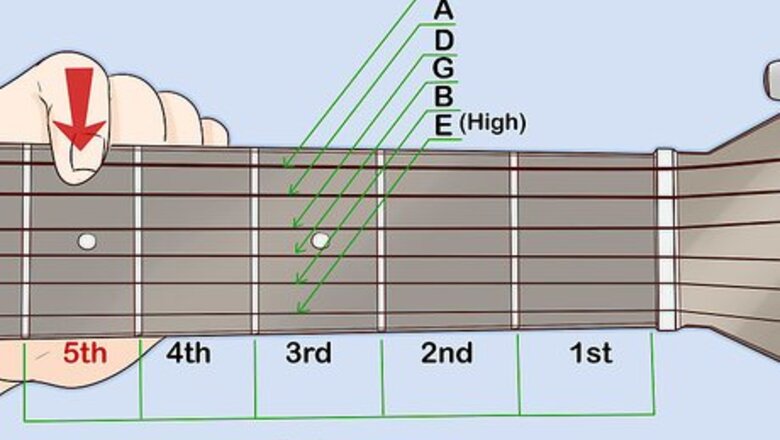
views
- To use the fifth-fret method to tune your guitar, tune your 6th string (low E) to a reference pitch, or leave it where it is if you’re only tuning your strings relative to each other.
- Play the 5th fret on the 6th string, then tune the open 5th string (A) to match pitch. Continue tuning the 5th fret from the A string to the D string and so on.
- The only exception is for the 2nd string (B). Play the 4th fret on the 3rd string (G) to tune the open B string instead of the 5th fret.
Tuning Your Guitar with the Fifth Fret Method
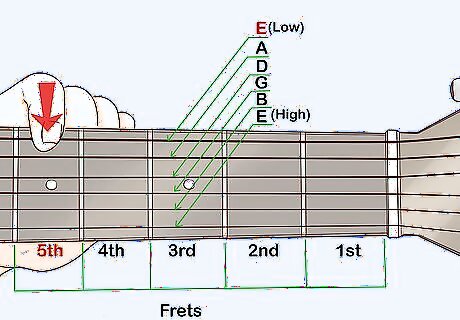
Fret the low E string at the fifth fret. The low E string, also called the sixth string, is the lowest and thickest string on your guitar. If you're holding your guitar in the playing position and looking down, it will be the top string closest to you. Pluck the E string while holding the fifth fret. The note at the fifth fret of the low E string is the same note, A, as the open A string (the next string over from the low E). It isn't necessary to first tune your low E string. Even though your guitar may not be tuned to concert pitch, the strings will be tuned relative to each other. Anything you play will “sound right” as long as you're playing by yourself and not with another instrument tuned to concert pitch.

Match the open A string to the low E string at the fifth fret. Listen to the pitch coming from the low E string when you play the fifth fret, then play the open A string. Tune the open A string up or down until it matches the pitch coming from the low E string. If the open A string sounds higher than the A you play at the fifth fret of the low E string, loosen the string to bring the pitch down, then tune it back up. To adjust the A string, slowly turn the tuning peg or head connected to the A string on the headstock. Tightening the string raises the pitch, while loosening the string lowers the pitch. The string pitches are the same on both acoustic and electric guitars, so you can use this method to tune electric guitars without a tuner as well.

Repeat the same process to tune the D and G strings. Once you have the A in tune, fret it at the fifth fret and pluck it. This is a D. Pluck the open D string and tune it up or down to match the fifth fret on the A string. When the D string is in tune, fret it at the fifth fret to play a G. Pluck the open G string and compare. Tune it up or down to match the sound. The interval between the E, A, D, and G strings is called a perfect fourth. This interval is 5 half steps wide, or 5 frets on a guitar string.
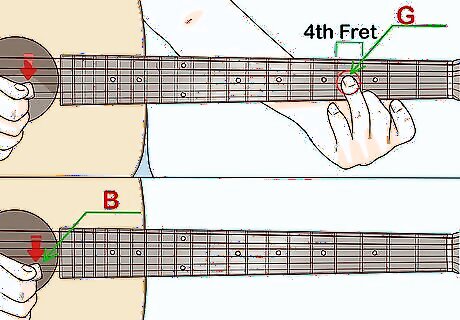
Fret the G string at the fourth fret to tune the B string. The process changes somewhat for the B string because there is a shorter interval between the notes G and B. Fret the G string at the fourth fret to play a B. Pluck the open B string and compare the sounds. Tune the open B string up or down until it matches the sound produced on the G string. The interval between the G and B strings is called a major third, which is only 4 half steps wide (or 4 frets on a guitar string) instead of 5.
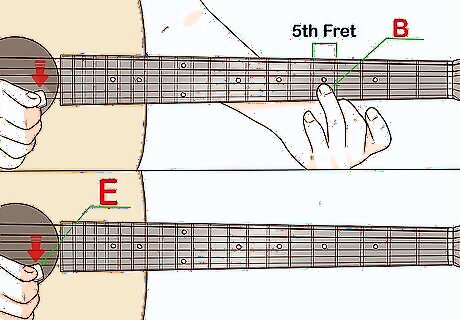
Return to the fifth fret on the B string to tune the high E string. Once you have the B string in tune, fret it at the fifth fret and pluck to play a high E. Tune the open high E string up or down to match the pitch coming from the B string. If the open high E string is higher in pitch than the high E played on the B string, tune it down and then bring it up to pitch gradually. The high E string is thin and has a lot of tension, so it may snap easily.
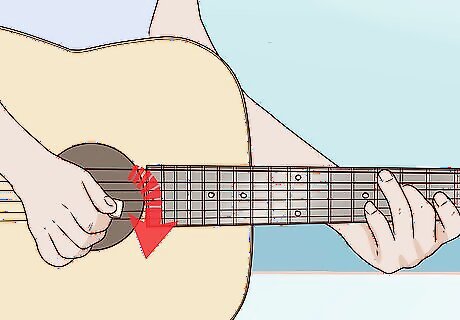
Strum a few chords to test your tuning. If you're getting ready to play a particular song, check your tuning with chords from that song to make sure it will sound okay. Listen carefully and adjust up or down as needed. Play a tune-checking chord made up of Es and Bs to tell if your guitar is in tune with itself. Bar the fourth and fifth strings with your index finger at the second fret. Fret the third string at the fourth fret and the second string at the fifth fret. Play both the first and sixth strings open. If your guitar is in tune, you will only hear 2 notes (Es and Bs in multiple octaves).
Using Harmonics to Tune Your Guitar
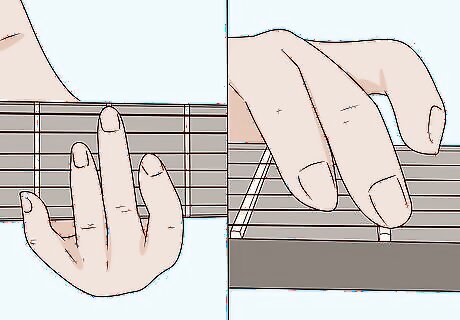
Practice touching any string lightly to play harmonics. Natural harmonics can be played at the twelfth, seventh, and fifth frets. To play a harmonic, touch the string just above the fret, without applying any pressure. Strike the string with your picking hand, releasing the string at the fret at almost the same time you pluck it. If you've never experimented with harmonics before, it may take a little practice before you can play them consistently. When you hear a bell-like sound, you've done it right. The harmonics method is a relatively quiet method of tuning. You may not be able to use it if you're in a place with a lot of background noise. A natural harmonic is an isolated overtone of a vibrating open string (all instruments produce overtones, which combine to form the unique tone of each instrument). The twelfth, seventh, and fifth frets isolate the octave, perfect fifth, and perfect fourth overtones, respectively.

Compare the E string's fifth harmonic to the A string's seventh harmonic. Play the harmonic on the fifth fret of the low E string, then play the harmonic on the seventh fret of the A string. Listen carefully and compare the pitches. You may have to play them several times. Tune the A string up or down until its harmonic exactly matches the pitch of the harmonic played on the low E string. If you haven't tuned your low E string to a reference note, your guitar will be tuned to itself but not necessarily tuned to concert pitch or to other instruments.

Repeat the same process with the D and G strings. Once your A string is in tune, play the harmonic on the fifth fret of the A string and compare it to the harmonic on the seventh fret of the D string. Tune the D string up or down as necessary to match the pitch. To tune the G string, play the harmonic on the fifth fret of the D string and compare it to the harmonic on the seventh fret of the G string.

Play the harmonic on the seventh fret of the low E string to tune the B string. The harmonic on the seventh fret of the low E string produces the same pitch as the open B string when you strum it. You don't need to play harmonics on the B string; just pluck the open string. Tune the B string up or down until it matches the pitch perfectly.

Tune the high E string using the harmonic on the seventh fret of the A string. The process for tuning the high E string is similar to the process you used for the B string. The open high E string should match the pitch produced when you play the harmonic on the seventh fret of the A string. When you've tuned your high E string, your guitar should be in tune. Play a few chords to make sure everything sounds right. The harmonics method is a great way to “fine-tune” your guitar after you’ve gone through a more robust tuning method, like the fifth fret method.
Using the Octave Method to Tune Your Guitar
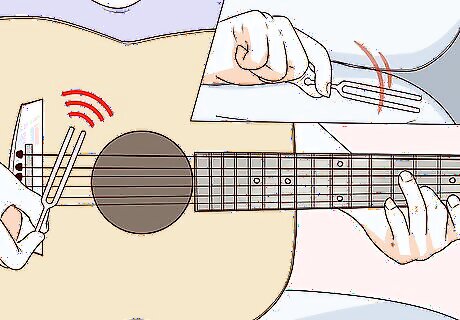
Use a tuning fork or other reference pitch to tune your D string. If you want to get your guitar close to concert pitch but don't have a tuner, use a reference note to get one string perfectly in tune, then tune the other strings relative to that one. A piano or keyboard can also give you a reference note (for one string or for all six). If you find a reference note for the D string, you can tune both your low E and high E strings quickly using octaves. You can use any string as a reference. However, if you use the D string, your guitar will be more in tune across the whole range of the instrument.

Fret the D string at the second fret and compare to the low E string. The note at the second fret of the D string is an E, but it is an octave higher than the pitch produced by the open low E string. Tune the open low E string up or down until they are playing the same pitch, but an octave apart. When the string is in tune, the sounds of the two strings will fit together, producing one rich sound. Even though the notes are an octave apart, you can still hear when they are in tune. If you have a hard time hearing it, use another tuning method until you’ve trained your ear to hear wide intervals. An octave is a musical interval between two pitches that are 12 half steps (or 12 frets) apart. Both pitches in an octave have the same note name (for example, low E to a higher E). Another way to hear octaves is to imagine the first and last note of a full scale (for example, the note do in do-re-mi-fa-sol-la-ti-do).
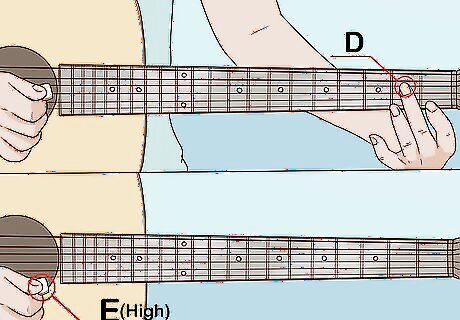
Compare the same note to the high E string. The E on the second fret of the D string is one octave lower than the open high E string. Carefully tune the high E string up or down until the two strings are in tune, an octave apart. The strings will sound together as one, without any “wobbling” in the sound. If the “wobbles” in the sound get smaller and less noticeable as you tune, you’re moving the pitch in the right direction. If the wobbles get wider and more dissonant, you’re going the wrong way. If the high E string is too high, tune it down first, then bring it up. Remember that you're tuning it one octave higher than your reference note (the E on the second fret of the D string). Be careful not to tune the high E string too high, or it may snap.
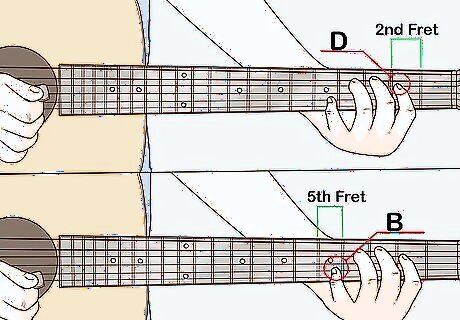
Match the second fret on the D string to the fifth fret on the B string. The E at the fifth fret on the B string is the same note as the open high E. Play the E on the second fret of the D string. While fretting the B string at the fifth fret, tune the string up or down until it is playing the same note one octave higher. While you can also tune the B to the open high E string, your guitar will be better tuned if you tune as many strings as possible to the same, single string.

Tune the A and G strings using relative tuning. From this point, the easiest way to tune the A string is to fret the low E string at the fifth fret and match the pitch of the open A string to that note (just like using the fifth fret method above). Then, use the note at the fifth fret of the D string to tune the G string. By following this method, you have tuned 5 of your 6 strings to the D string. Play a few chords to make sure your guitar sounds right, making adjustments where necessary.










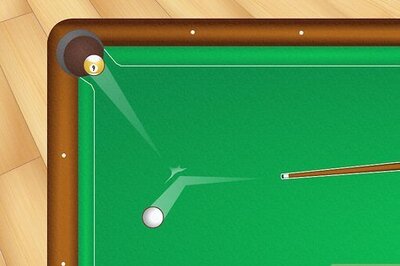




Comments
0 comment